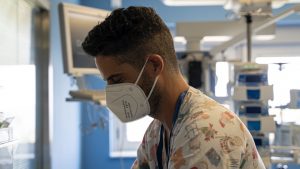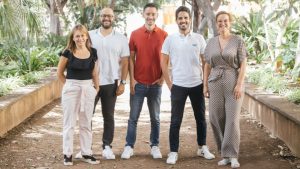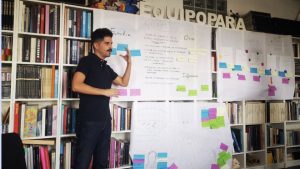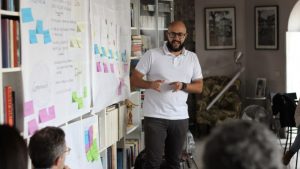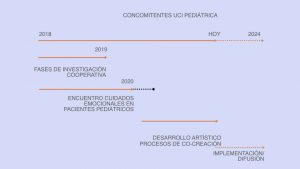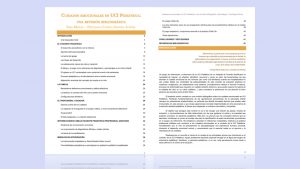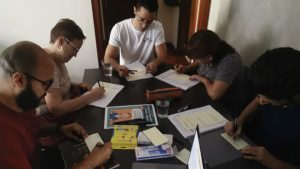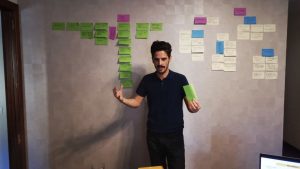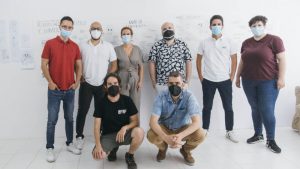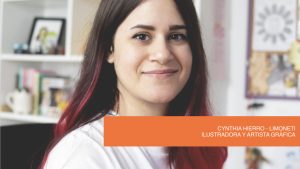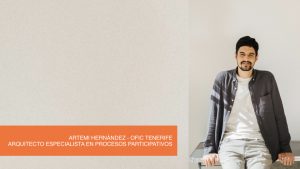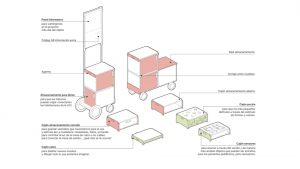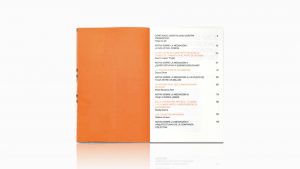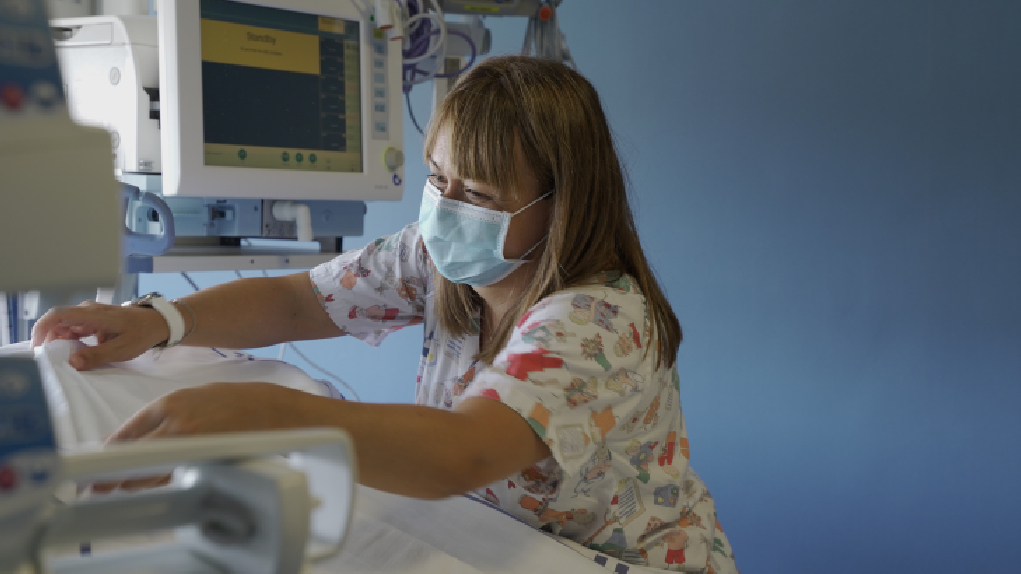
Concomitentes: Pediatric ICU
All the links point to websites in spanish.
What
ZEMOS98 took charge of the mediation process for the Pediatric ICU as part of its involvement in “Concomitentes.” In 2018, work began with Laura León, Lili Quintero, Quique Chinea, Severiano Torres, and Ruymán Miranda, the nursing staff of the Pediatric ICU at the University Hospital Nuestra Señora de Candelaria in Tenerife (HUNSC). The goal was to co-create a work of art or cultural project that would help improve the emotional care of pediatric patients and their families.
The methodology of Concomitentes proposes the creation of co-creation spaces to develop cultural projects resulting from a mediation process between civil society agents and artists. This process has generated many intangible and difficult-to-document learnings, one of which is the bibliographical review of the state of emotional care in pediatric patients in Spain, carried out by child and adolescent psychologist Sara Miguel. It was presented at the “Gathering on Emotional Care in Pediatric Patients“, organized as part of the project in February 2020. A document was also presented listing a total of twenty-seven situations that generate emotional stress in patients or their families, all identified by the nursing staff in the Pediatric ICU.
Thanks to the generosity of the nursing staff involved in the project in overcoming the hurdles posed by the early months of the pandemic and the careful on-site work between production and mediation by Andrés Cabrera Gil, we were able to start working on the three planned works from March 2020. Between September 2020 and June 2022, many video calls and several in-person meetings were held, weaving a common code that resulted in these three works:
1- “Hospitalario” (Hospitable) an illustrated story for children aged approximately four to ten, written by El Hematocrítico and illustrated by Cynthia Hierro.
2- “En la UCI Pediátrica” (In the Pediatric ICU) a podcast for all audiences that narrates the life of the nursing staff involved in the project, directed by Elena Cabrera and distributed by ElDiario.es.
3- “La Cuidateca” (The Care-shelf) a mobile library designed by Artemi Hernández from the Civic Innovation Office of Tenerife, in collaboration with Octavio Barrera and with the support of the CajaCanarias Foundation.
In addition to the three works, Concomitentes and ZEMOS98 worked together with the Bartlebooth publishing house for the publication of the book “Hospatilidad contra pronóstico” (Hospitality against the odds), which is established as a publication on “Concomitentes-Pediatric ICU” to try to understand how care is produced in environments where life shows all its fragility, where imagination and artistic thinking have an indispensable place. This publication seeks to draw lines of escape and reflections based on what the mediation process has entailed. Collaborating in this publication are: Noemí López Trujillo, Javier Padilla, Ethel Baraona, Diana Oliver,Noelia Ibarra,Sabina Urraca and Simone Turinese.
The publication also contains some “Mediation Notes”, which serve as an introduction to each of the texts, expand a little more on the context of the project and serve as a space to reflect on the mediation process. They are written by Felipe G. Gil, mediator on behalf of ZEMOS98 of the project.
Concomitentes Pediatric ICU generated a conversation in the Auditorium of the University of La Laguna in November 2021 and was presented at an event titled “Culture that heals” at the Cajacanarias headquarters in Tenerife on September 15, 2022 and at Caixaforum Madrid the June 1, 2023. Besides, has won the “Special Nursing Development Award 2022”.
How
Concomitentes originated from a sister project in France, with a well-established track record: “Les Nouveaux commanditaires.” In this project, and based on a protocol written in 1990, artist François Hers defined mediation as “establishing connections between the works and the public, also linking people: the artist, the client, and more broadly, all the social actors involved.” The mediator is also later requested to be the person who “organizes cooperation” between the parties.
Concomitentes already has several mediation processes that will help us better understand the specificities of mediation work. For ZEMOS98, it has been another step in their experience of creating co-creation spaces that allow people from different backgrounds and professional contexts to work together to create a common good.
Anastassia Makridou-Bretonneau delivered a speech at “Cultura que cura” and perfectly defines the ‘how’ of this project and the importance of mediation:
“The mediator mobilizes a wide range of skills simultaneously: listening, facilitating meetings and internal and external relations, analyzing and translating the expectations and needs of the clients into artistic challenges, cultural engineering, economic management, communication, and more. The list could be quite long. With these skills, the mediator maintains, like the beautiful fire in the center of old houses, the desire and commitment of everyone, ensuring the quality of dialogue and debates, balancing the expectations of the clients with the creative freedom of the artists. These are, among others, the fundamental functions of the mediator. But projects are not smooth rivers that flow effortlessly to the sea. The Pediatric ICU team has already experienced this. Being a versatile mediator also requires human qualities such as empathy and perseverance. Therefore, if I had to conclude by describing the role of the mediator with just one sentence, I would say that it is the ‘architect of collective trust.’ It is a trust that allows us to break free from our individualism, emancipate ourselves from our compartmentalized systems, to engage with something broader, more generous, and shared. Thus, every project accomplished is a victory against immobility and fatalism, another proof that civil society can actively and creatively engage in public affairs, and that art is an essential actor in changing our world. The mediator is nothing more and nothing less than a humble servant of these magnificent causes.”
Why
“Concomitentes-UCI Pediátrica” leaves behind many lessons, many of which will remain with the people who have been part of this journey. Some can be named, such as the importance of valuing cultural mediation as a space where architectures of trust are built, the idea that health, beyond healthcare spaces, is sustained through the care of millions of people, most of whom are women. The importance of valuing these jobs, both in domestic spaces and in professional settings such as a Pediatric ICU. That no matter how small or young a person is, their emotions should not be underestimated. That medicines heal, but stories do too. That we need imagination to improve as a society: the imagination of children, but also that of adults dedicated to art and culture, trying to create narratives or devices that help us progress toward a society where health is seen as a common good.
Resources
The Concomitentes website has provided comprehensive (in Spanish) coverage of the project, including interviews with artists and nursing staff, chronicles of the events that have taken place, and other valuable materials.
https://concomitentes.org/concomitancias/uci-pediatrica-tenerife
Date
2019 - 2022
Scale
National
Role
Coordinator
Services
Media production, Mediation





